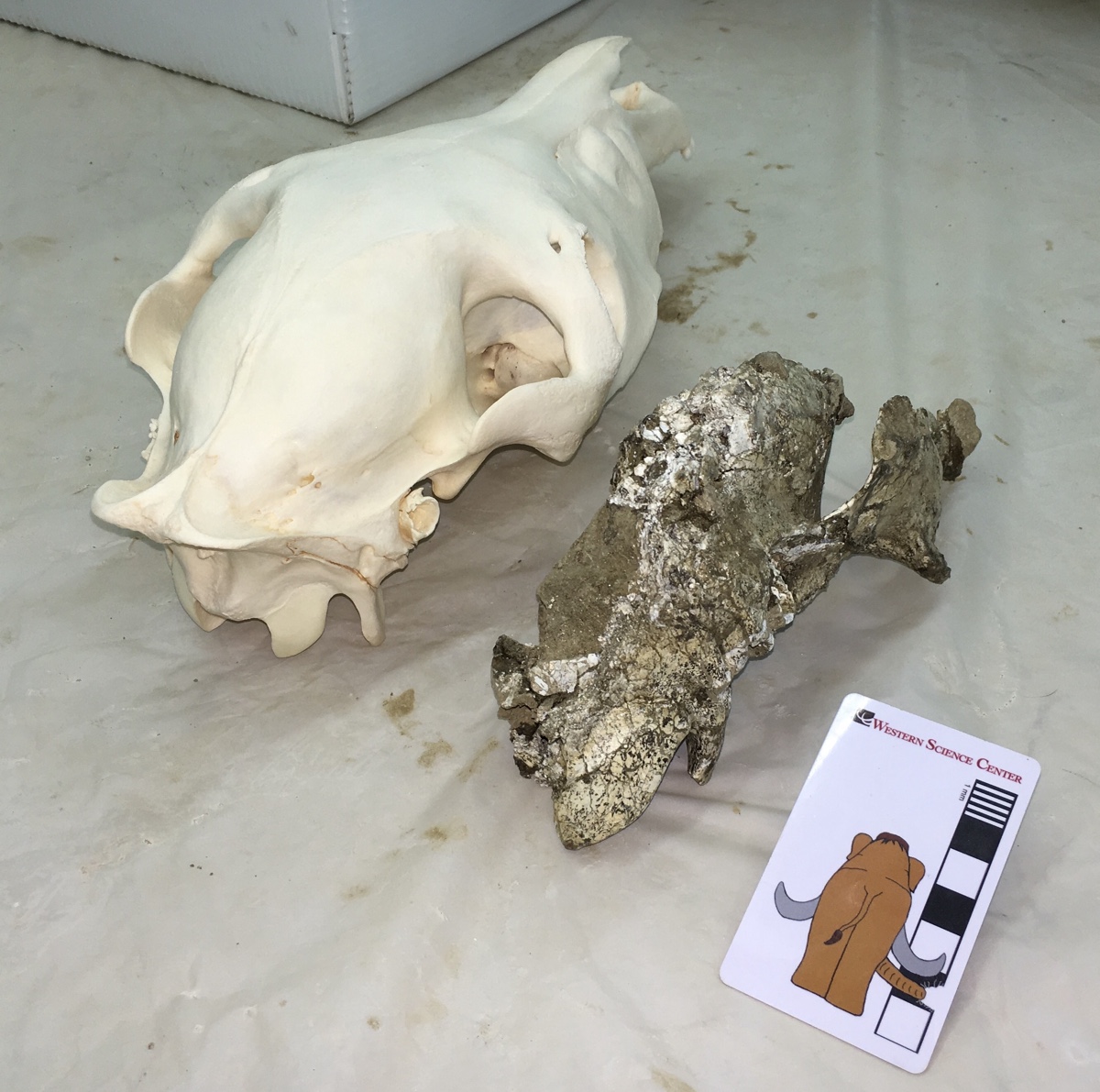 Vertebrate paleontologists rarely get to examine whole skeletons (really, almost never). Even individual bones or regions such as skulls are usually fragments, often broken in odd ways, and identification can be a challenge. That's why paleontologists will keep around lots of well-illustrated references, reference collections of modern animal skeletons, and increasingly, 3D images of identified specimens. A lot of identification work is just comparing your unknown specimen to known ones and finding a match.For the last several weeks WSC volunteer Nathan Bonde has been preparing a block of sediment that came to the museum through a mitigation project (unfortunately with rather limited data). The sediment had several bone and possible tooth fragments sticking out, but it wasn't immediately clear what the material was or if it all belonged to the same animal.
Vertebrate paleontologists rarely get to examine whole skeletons (really, almost never). Even individual bones or regions such as skulls are usually fragments, often broken in odd ways, and identification can be a challenge. That's why paleontologists will keep around lots of well-illustrated references, reference collections of modern animal skeletons, and increasingly, 3D images of identified specimens. A lot of identification work is just comparing your unknown specimen to known ones and finding a match.For the last several weeks WSC volunteer Nathan Bonde has been preparing a block of sediment that came to the museum through a mitigation project (unfortunately with rather limited data). The sediment had several bone and possible tooth fragments sticking out, but it wasn't immediately clear what the material was or if it all belonged to the same animal. It quickly became apparent that the tooth was from a horse, apparently a upper left 3rd premolar or 1st molar (shown below next to a zebra skull from Brett's collection):
It quickly became apparent that the tooth was from a horse, apparently a upper left 3rd premolar or 1st molar (shown below next to a zebra skull from Brett's collection): The bone fragments were a little tougher. Continued cleaning showed that most of the bone joined together into a single large fragment, shown at the top of the page. The size and overall complexity suggested a skull fragment, which was bolstered by the presence of a bony tube that looked like the external auditory meatus, part of the ear structure. Since we knew that a horse was a strong possibility (based on the tooth), we compared the fragment to the zebra skull:
The bone fragments were a little tougher. Continued cleaning showed that most of the bone joined together into a single large fragment, shown at the top of the page. The size and overall complexity suggested a skull fragment, which was bolstered by the presence of a bony tube that looked like the external auditory meatus, part of the ear structure. Since we knew that a horse was a strong possibility (based on the tooth), we compared the fragment to the zebra skull: If you're having trouble seeing how these match up, here's an annotated version:
If you're having trouble seeing how these match up, here's an annotated version: The area outlined in red on the zebra skull is the approximate preserved part of the fossil; note that the fossil is quite a bit larger than the modern specimen. The numbered features are:
The area outlined in red on the zebra skull is the approximate preserved part of the fossil; note that the fossil is quite a bit larger than the modern specimen. The numbered features are:
- Right occipital condyle (the articulation with the 1st neck vertebra)
- Condyloid fossa
- Jugular process
- External auditory meatus
- Glenoid fossa (the articulation point for the lower jaw)
- Temporal fossa (opening for the muscles that close the lower jaw)
- Zygomatic process of the squamosal (cheekbone)
Here's another view, oblique and from behind, showing more clearly how the zygomatic process projects out, forming the lateral side of the temporal fossa: Tooth size is apparently not a reliable indicator of body size in horses, and our modern specimen is both sub-adult and a relatively small animal. Nevertheless, in this instance we seem to be dealing with a fairly large horse; both the tooth and the skull fragment are much larger than our reference skull. If you look closely at the images above, you may also notice differences in the shape of the enamel ridges on the teeth, and somewhat different shapes and orientations in some of the cranial bones. While both these skulls are from the genus Equus, they do not represent the same species, which isn't really surprising considering that they're separated by at least 10,000 kilometers and at least 20,000 years.
Tooth size is apparently not a reliable indicator of body size in horses, and our modern specimen is both sub-adult and a relatively small animal. Nevertheless, in this instance we seem to be dealing with a fairly large horse; both the tooth and the skull fragment are much larger than our reference skull. If you look closely at the images above, you may also notice differences in the shape of the enamel ridges on the teeth, and somewhat different shapes and orientations in some of the cranial bones. While both these skulls are from the genus Equus, they do not represent the same species, which isn't really surprising considering that they're separated by at least 10,000 kilometers and at least 20,000 years.
